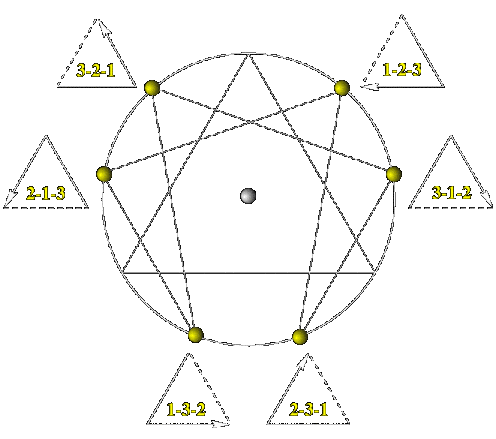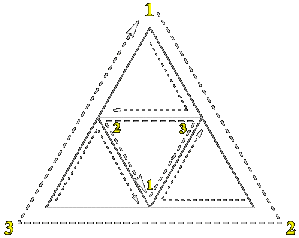Naranjo and Beatrice Chestnut explain the instinctual variants for all the 9 types as strict behavioral tendencies or styles or subtypes for all the types (3x9), based on Ichazo's original observations of the instinctual variants though he was less concerned about understanding them as subtypes as much as he noted on specific areas of focal interest within the types e.g. calling the sexual 6 strength and beauty, because the sexual instinct is focus on impressing or attracting intimates, and when coupled with type 6 will manifest as the 6 focusing on trying to overcome their weaknesses by coming across as brave, courageous or strong. Naranjo later translated this with the terms phobic and counterphobic, where the phobic type would be sp and the counterphobic sx.
Was this done for any of the other types? 6 seems to be the only one I've seen that has those two special categories added (or maybe I did see others, and didn't realize it was the same thing).
Then why even have it as a specific distinct temperament? How do you know whether someone is choleric then, if it will always mimic that of other styles? Based on my historical understanding of Hitler, I don't think he was a choleric type either, but most probably melancholic at his core. He wanted to be an artist who went kind of nuts with the advent of WW I and how he was treated by the Jews and the Jewish community. Because of his mental health problems, I don't think one can truly type him in such a way anyway, because he would not behave or operate within the range of an average person because he never was except if one accounts for how he was like prior to his rise to power.
There are still ways to tell. Their behavior will ultimately be all about the goal, not about people, who are ends to a means. Like everyone says he "uses so much Fe", but Feeling is personal, and his solution was very IMpersonal; treating millions of people as objects to be eliminated. Him doing it for the sake of "the people" he identified with as his countrymen doesn't fit. Fe might be more localized (one's own group before outsiders), but it's still environmental (external), and ultimately seeking harmony; and the actual decision making as it related to the "others" does not fit that. What would fit is an impersonal Te agenda that used the countrymen as justification for a larger goal.
Though I would acknowledge him being possibly Melancholy or at least part Melancholy, or even nearly untypeable (which I think Jung himself even said).
Based on my understanding of choleric, I wouldn't associate INxPs in general with the choleric trait, simply because INxPs are the least focused on Se style of interaction, which is direct and forceful, which is something INxPs shy away from.
Well, you're associating Choleric with Se, which I don't, necessarily. One of the Se dom's, ESFP, is the Sanguine, not the Choleric. (Which is also aggressive, but the difference is that they do not hold on to the aggression as long).
Of course, Se will figure in the ESTP, and in tertiary form, for the ENJ's. For ESTJ, it will be the dominant Te (which is really the most "choleric" of the functions). For the NTP's (not NFP's), it will be less evident, but still lie in the pragmatism (classic "hot", or leading to another kind of "aggressiveness"), and structure focus (classic "dry", which adds a critical element).
I don't identify with in-charge because of the pragmatism and structure focus of being an NT seeing how I'm staunchly Ni first and not quite as Te even when compared to other INTJs and I rarely emphasize Te much, but I do because of the pragmatism and focus on action as a type 8. I don't identify as in-charge because I personally relate to the style, but I identify as in-charge because I think it best describes my actual interaction with other people and how I am in group projects. I very often take immediate and direct control of the group and the group project, especially if the current leadership is found to be incompetent, and begin to give out directives as to how we should best accomplish whatever we want to accomplish.
But the Ni and Te together is what makes an NT. So it is still connected. And no matter how much you may lean toward the dominant over the auxiliary, it is still there, and shapes the behavior of the type. With me, it's Ti and Ne, and both of those "softer" or even "airier" than Ni and Te (and this basically is the J/P distinction). I'm not as able to direct control of groups (and this is again, why the NTP's are the least Choleric-like of the seven Choleric types), but it does still come out in trying to direct in a more passive or indirect fashion. The common thread with either version of N+T is a sense of strong ideas of the way things should logically be, which we will then try in one way or another, to implement (hence, "pragmatism").
This doesn't make any sense to me at all, tbh. I don't even see the value in making these kinds of connections and associations, personally, as I think all these are very distinct ideas that don't neccessarily overlap in such a way. I don't see what makes chart-the-course melancholy for example. My girlfriend is an ESFP, she doesn't fit get-things-going at all but is more accurately depicted as chart-the-course. I just don't believe in that just because something is X type. She also happened to be a 6, that you associate with supine. I don't think she's supine at all as I see her best described as being of the Prussian style, though she's not a social variant either. This is the problem with behavioral correlations. They are that, but people take them to be causative and set in stone when they never truly are. People are too complex to ever fit the mold like that. The system should be shaped to be adopted to the people and how they are like, rather than making people fit into the boxes within the narrow confines of the system.
Again, that's why I'm not big on the new names. They are everyday [almost, at least] terms that anyone can do, and so you get something like what you describe. (And again; I've backed off largely from the Enneagram correlation, but and see there can be some cross-talk, so to speak like that ⦅Sanguine and Supine are close to each other, actually⦆. I wonder if she has a 7 wing, or 3 in her tritype, though).


